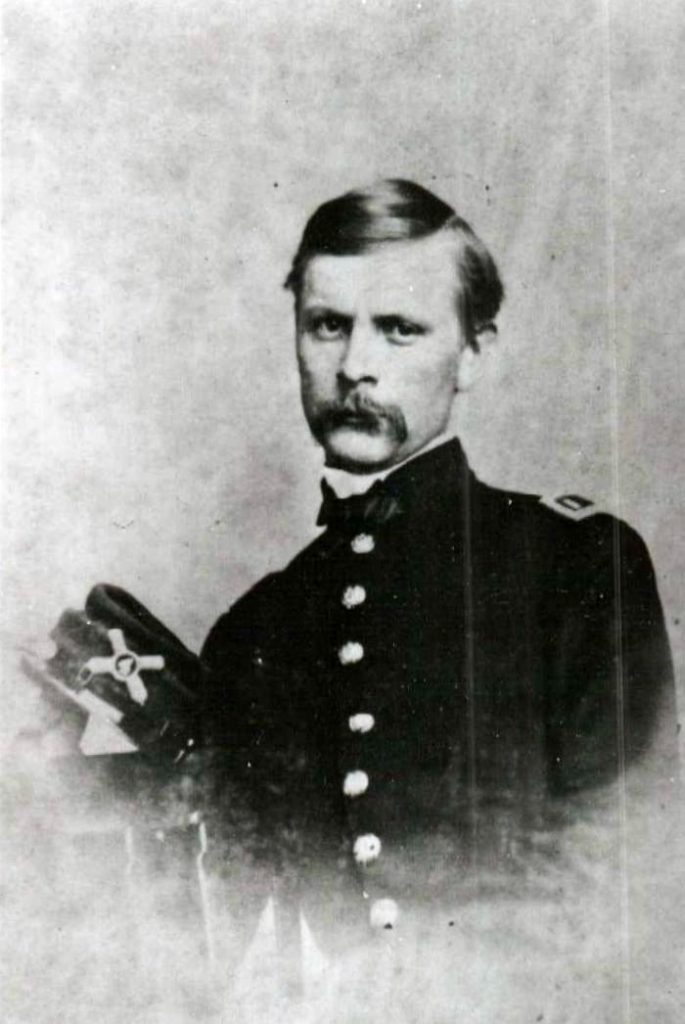More Closely Engaged Than Any: Lt. Charles Parsons at the Battle of Stones River
Just before noon on New Year’s Eve, 1862, William S. Rosecrans’ Army of the Cumberland had been partially routed and battered by Confederate assaults against its right flank. Braxton Bragg’s attacks ripped four Federal divisions and captured 28 guns. Rosecrans’ command was now bent double back on its itself, arrayed along the Nashville Pike, its line of communication back to its base of supply. The Confederates had to be stemmed here, Rosecrans knew.

John Palmer’s division held the crux of the V-shaped line. Its left was anchored in the Round Forest on the east side of the pike and extended across the pike ready to repel additional enemy assaults from the south. William Grose’s brigade held Palmer’s right. Earlier in the day, that brigade faced southeast but the turning of the Federal right forced Grose to front his brigade facing west to protect his rear against the enemy. Lt. Charles Parsons, an 1861 graduate of West Point, deployed his eight gun battery in the midst of Grose’s infantrymen. Staring across a cotton field into cedar woods, Parsons’ cannoneers prepared themselves for the next enemy advance.
The first sign of trouble Parsons’ gunners witnessed was retreating Union infantry streaming from the woods to their front. The Confederate brigade of Brigadier General James Rains followed the withdrawing Federals into a cotton field in front of Parsons’ guns. Headed for the Nashville Pike in their front, Rains’ line of advance was not directed towards Parsons’ guns but instead parallel to them. The advancing Confederates, aiming to severe Rosecrans’ supply route and achieve a resounding victory, charged out of the cedars into the face of 36 Federal guns and several regiments of infantry. “Now was the time for the artillery–fate relied on them here–and such a roar of cannon never was heard before,” wrote a member of Parsons’ command.
Taking note of the splendid opportunity in front of him, Lt. Parsons prepared his men. They waited until Rains’ line approached within 300 yards of the battery with its left flank exposed. “Fire!” belted out the lieutenant. “We opened upon his first line and column of reserves an enfilade fire of canister,” Parsons wrote. “Here was the struggle for the day, and a hard one it was,” remarked Col. Robert Vance of the 29th North Carolina Infantry.
Not only did the fire of Parsons’ artillery wreak havoc in the Confederate ranks but so too did the rest of the Union guns and infantry positioned astride the pike. General Rains fell mortally wounded from his horse. Thirteen bullets pierced the flag of the 29th North Carolina. No humans could bear such a fire and Rains’ brigade, minus its commander and many casualties, pulled back to the cover of the trees. “After we had ceased firing not a rebel was to be seen, with the exception of a squad of 8 or 10 who rose from their hiding places with a white handkerchief, and hollering, ‘don’t fire;’ they were our prisoners,” remembered John Carroll, one of the men under Parsons’ command. For now, the line of the Nashville Pike was held.

Though Rosecrans’ line along the road to Nashville held, Parsons’ gunners were not done for the battle, nor the day itself. Later in the afternoon, they assisted in repelling more Confederate assaults from the south. On the battle’s final day, January 2, 1863, the rifled guns of Parsons’ Battery aided in stopping the last Confederate assault of the battle. In doing so, these exhausted gunners literally fired the last shots in their limbers and caissons.
In five days of action during the Stones River Campaign, Parsons’ eight guns fired 2,299 rounds of ammunition, more than any other battery in the Army of the Cumberland. “I have to remark, in this connection,” Parsons reported, “that if through the five consecutive days, during which we were thus more or less severely engaged, we expended an unusual amount of ammunition, it must be recognized that we have been longer, and, in general, more closely engaged than perhaps any others batteries of the army, and that nearly all our ammunition has been expended at short range.”
Parsons, less than two years out of West Point, earned his second brevet of the war at Stones River (the first came from his actions at Perryville). Unfortunately, it would be Parsons’ last fight in the field, his health too broken down to continue further. He died in 1878. In his obituary, a simple epitaph concluded Parsons’ life: “He did his duty for duty’s sake.”
Nice article Kevin. I think it is worth noting as well that Parson’s command was able to fire those 2,299 rounds while also suffering 2 killed, 14 wounded, 6 missing and 20 horses killed according to his report. Division commander Palmer wrote of Parsons “My orders to Parsons were simple, “Fight where you can do the most good.” Never were ordered better obeyed.”
If anyone is interested in the full maps of the snip shown in the article, the full series from Ed Bearss is available on the NPS site below. The maps are a great resource.
https://www.nps.gov/stri/learn/historyculture/troopmaps.htm
Kevin: Thanks for another excellent article. Of course, just to demonstrate how “brain washed” I’ve become from repeatedly applying Henry Hunt’s “rules”, my first thought was: “2,299 rounds. That’s about 60 rounds per gun per day, or more than one chest for smoothbores. Did the Lieutenant not know what he was costing his Government?” I sense that Brother Hunt would have required a report specifying what was being used at what targets and at what ranges. And it had better not have been canister. 🙂